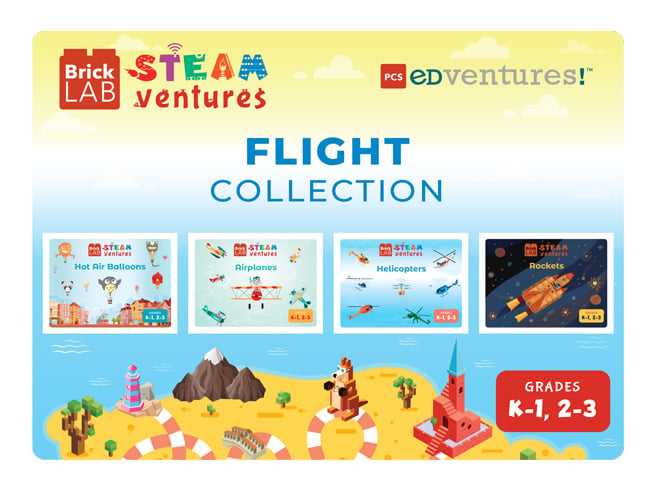
5 Ways to Prepare for a STEAM-Filled Year
After a much needed summer break, you walk into your learning space to find boxes stacked high, bulletin boards covered and tables pushed aside. You smile, then sigh as your thoughts are pulled in two separate directions: “This new year brings so many possibilities!” and “I’m entirely overwhelmed.”
You’ve already heard about the benefits of STEM or STEAM (Science, Technology, Engineering, Arts and Math) instruction. Learners can gain invaluable skills from its hands-on, collaborative approach to learning. It’s engaging, thought-provoking, meaningful work. Still, you’re not sure where to begin.
We have GREAT news! Getting any learning environment ready for a year full of quality STEAM instruction is simpler than you think.
Consider these 5 areas as you prepare for the year ahead and you’ll skillfully master the art of STEAM integration:
- manipulatives
- organization
- routines
- communication
- curriculum
Soon, learners will be lining up at your door for compelling, cross-curricular experiences. All it takes is a little pre-planning whenever you’re ready to start your STEAMventure.
For a quick STEAM reference guide and resources, download our Back-to-School STEAM Checklist.
Setting Up for STEAM Instruction
1. Stock Up on Manipulatives
Part of STEAM’s magic is its consistent use of hands-on learning tools. Give learners something to build or explore, and suddenly concepts are more engaging and problem-solving more inviting. But with so many options available, which manipulative is the best investment when you’re just beginning to take on STEAM? Interlocking bricks.
These small, familiar learning tools are so versatile you’ll soon find yourself integrating them into daily lessons.

Let’s look at one example from our Earth Activity Cards freebie, in which learners build a type of flower using bricks. This seemingly simple design challenge opens the door for many cross-curricular teaching points:
Science
Plants play a major role in every ecosystem.
Discuss that all animals depend on plants. Some animals eat plants for food. Other animals eat animals that eat the plants.
Math
Symmetry can be found in nature.
The number of times an image looks the same during a 360-degree rotation determines the number of “folds.” For example, if the flower is rotated 180 degrees and appears the same, it would have two-fold symmetry. As a formula, this looks like 360/n=folds, ie. 360/180=2.
Social Studies
Plants can inspire art and help solve problems within a community.
Investigate how various cultures use certain plants found in their homelands to solve problems and/or create cultural art.
Language Arts
Dive deeper through research.
Discover more about the chosen plants by researching their uses, habitats and needs for survival.
With numerous cross-curricular connections, bricks offer educators a simple way to engage learners while teaching core standards. See for yourself by downloading our free BrickLAB Earth and Celebration Activity Cards.
On the hunt for quality interlocking bricks? Check out our signature “Perfect Bricks” to instantly turn your curriculum into a hands-on learning experience!
2. Organize Your Learning Space
Now that you have your own set of go-to manipulatives, it’s time to create a STEAM command center.
STEAM is collaborative, hands-on and exploratory. It encourages learners to take the lead, giving them the autonomy to move freely around a learning space to gather materials or have discussions with their peers. How you design your learning environment should be purposeful and conducive to self-directed learning.
Start by creating a flexible layout. Will your learners sit at tables or desk clusters that can be changed around? Can space be made to fit a large group? Is it easy for learners to move and work around the room? The more options you have for how learning space can be used, the better!
3. Establish Routines
Your materials are organized and your learning space is set. Next, you’ll want to consider what routines will help you and your learners feel confident from day one.
STEAM icebreakers are the perfect way to start teaching into routines while encouraging learners to build relationships with one another. Both are essential to the success of a STEAM lesson. When learners are comfortable with expectations and their ability to collaborate with others all the pieces begin to fall into place.
Looking for STEAM-themed icebreakers you can use right away? Check out these free resources that get learners moving, sharing and discovering alongside their new classmates:
4. Communicate with Families
Having families' support throughout your STEAM journey is immensely helpful. Learners often want to share their experiences with those at home, especially following an exciting design challenge. Encourage this always! Here are a few ways to do so:
- Share pictures of learners engaging in STEAM challenges on a (private) social media platform.
- Invite families in to watch or help with a STEAM activity.
- Send a letter home at the start of a STEAM unit to keep parents in the loop.
- Encourage families to try STEAM activities at home.
There are so many online STEAM resources families have access to it can be difficult to sort out which to share with them. Luckily, PCS Edventures has compiled a list for just this purpose! Check out 13 Tools Educators Use to Engage Students and their Families for a full list of resources.
We also have many great options of our own that you’re sure to love. First, watch our Home Learning with BrickLAB STEAMventures webinar. You’ll explore best practices and strategies for educators interested in partnering with families to support at-home learning. It’s a can’t-miss workshop available to view on your own schedule.
Next, you’ll find a wealth of online STEAM resources on our BUILD STEAMventures website. Learners and families can explore the science behind various forms of transportation, flight and food through exciting activities and videos. Best of all, this resource complements three fabulous activity book collections full of learning experiences families can try together. Find out more below.
Last but not least, we’ve gathered 25 days worth of hands-on STEAM challenges that use common household items. Our 25 Days of STE(A)M freebie lets learners celebrate the holiday season with activities based on many of PCS Edventures’ engaging programs.
5. Choose STEAM Classroom Activities Relevant to Your Curriculum
With so many standards to meet throughout the school year, educators should make the most of every lesson. Thanks to STEAM’s flexible, cross-curricular structure, you can teach several subjects in less time!
Start collecting STEAM resources that make the most of your curriculum. The more you have on hand, the easier it will be to incorporate them into your instruction organically. To get you started, we’ve assembled a list of free resources to download and use in your learning environment throughout the school year. Each features core subjects that can be used in several different ways.
- Fractured Folktale: Paul Bunyan (English Language Arts and Engineering)
- Geometric Marine Life (Math, Science, and Art)
- Exploring Earthworms with Dirt Art (Art, Earth and Life Science)
- Martian Weather Report (Math and Science)
- Sweat It Out With 5 Frisbee-Based STEM Games (Physics and Physical Education)
- Operation Animal Conservation (Art and Environmental Science)
- Soar like Superman with STEM (Science and Math)
Loving these activities? Discover the programs that inspired them by exploring our Program Catalog! This all-in-one resource lets you see the standards that align with each STEAM program at a glance.
If you’re planning a full year of STEAM instruction, visit A Year of STE(A)M for all-inclusive enrichment solutions.
Conclusion:
Now that you’ve taken the time to consider STEAM manipulatives, organization, routines, communication and curriculum, breathe a sigh of relief! You’re ready for a STEAM-filled school year that will allow your learners to thrive.
Be sure to bookmark this page to refer back to its resources throughout the school year. You can also download our Back-to-School STEAM Checklist for more ideas that will help you feel confident implementing STEAM in any learning environment.
What questions do you have about implementing STEAM?
Leave a comment below!

Author: Jessica Ventre
An experienced elementary educator and science instructional coach, Jessica’s passion for STEM instruction and student-led learning is always at the forefront of her lessons and professional development workshops.













